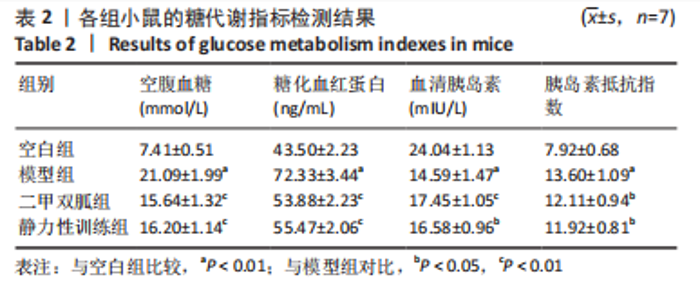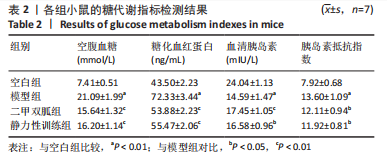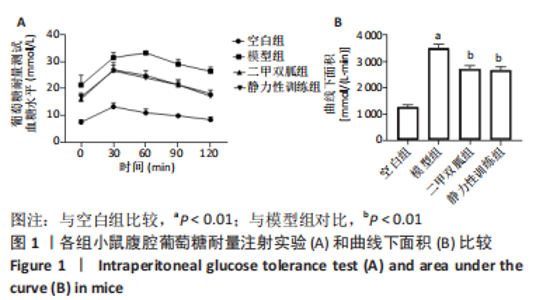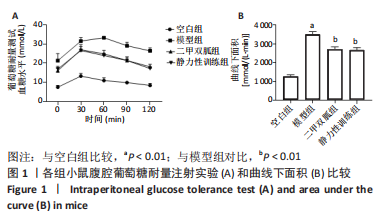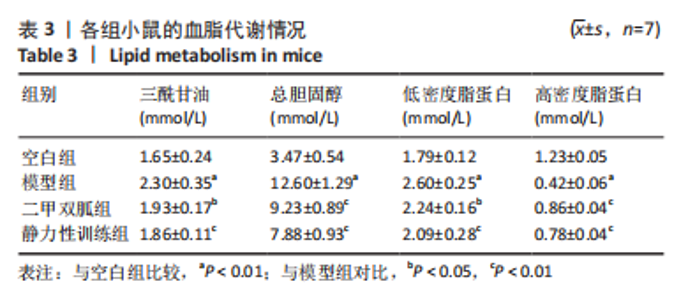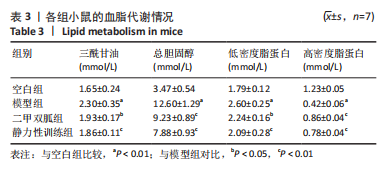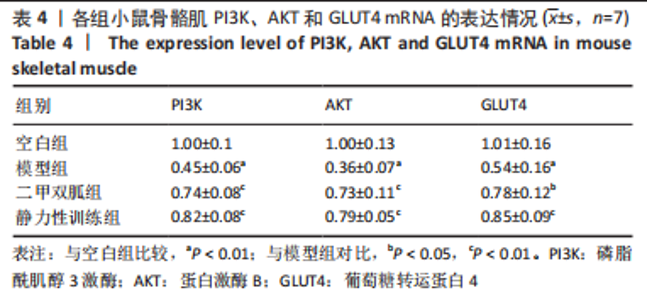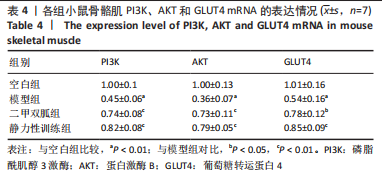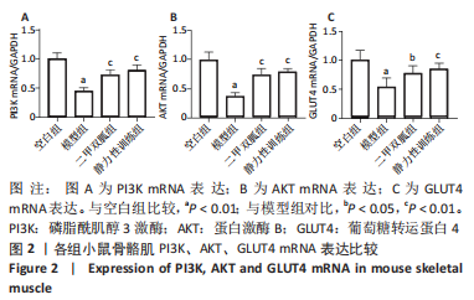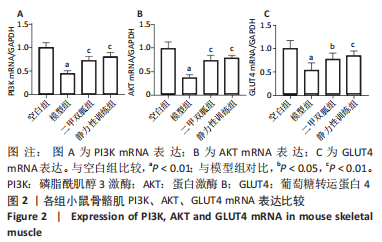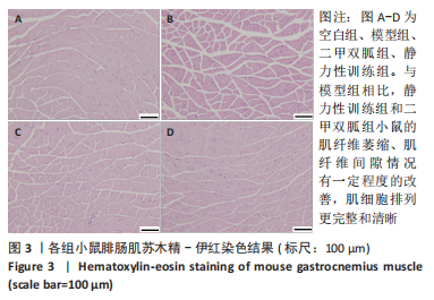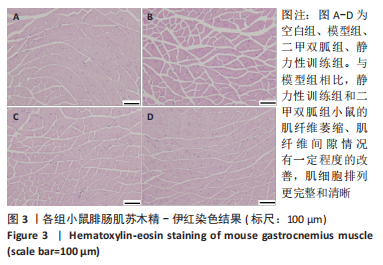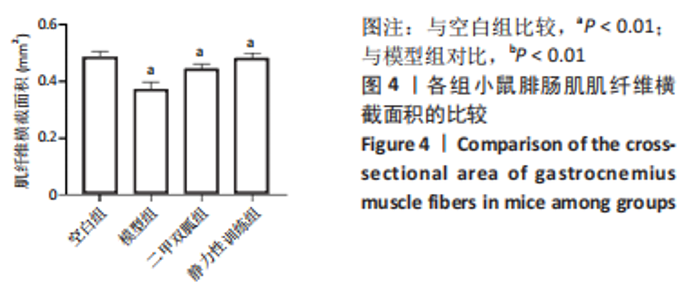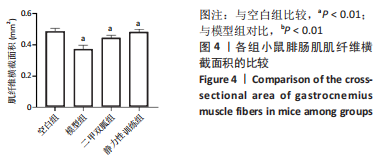[1] International Diabetes Federation.IDF Diabetes Atlas,10th edn(2021-9-12) [2022-3-17]. 2021.
[2] LEE SH, PARK SY, CHOI CS. Insulin Resistance: From Mechanisms to Therapeutic Strategies. Diabetes Metab J. 2022;46(1):15-37.
[3] VERBRUGGE SAJ, ALHUSEN JA, KEMPIN S,et al. Genes controlling skeletal muscle glucose uptake and their regulation by endurance and resistance exercise. J Cell Biochem. 2022;123(2):202-214.
[4] HUANG X, LIU G, GUO J, et al. The PI3K/AKT pathway in obesity and type 2 diabetes. Int J Biol Sci. 2018;14(11):1483-1496.
[5] O’NEILL HM, MAARBJERG SJ, CRANE JD, et al. AMP-activated protein kinase (AMPK) beta1beta2 muscle null mice reveal an essential role for AMPK in maintaining mitochondrial content and glucose uptake during exercise. Proc Natl Acad Sci U S A. 2011;108(38):16092-16097.
[6] WHILLIER S. Exercise and Insulin Resistance. Adv Exp Med Biol. 2020;1228: 137-150.
[7] 首健, 陈佩杰, 肖卫华. 不同运动方式对骨骼肌胰岛素抵抗的影响机制[J].中国糖尿病杂志,2018,26(8):697-701.
[8] AMANAT S, GHAHRI S, DIANATINASAB A, et al. Exercise and Type 2 Diabetes. Adv Exp Med Biol. 2020;1228:91-105.
[9] YAN J, WANG C, JIN Y, et al. Catalpol ameliorates hepatic insulin resistance in type 2 diabetes through acting on AMPK/NOX4/PI3K/AKT pathway. Pharmacol Res. 2018;130:466-480.
[10] 陈致瑜,刘率男,罗振华,等.二甲双胍对高脂饮食诱导的2型糖尿病小鼠胰岛β细胞功能的改善及机制探讨[J]. 药学学报,2017,52(10): 1561-1567.
[11] 张宏, 徐俊, 严隽陶, 等. 改良的大鼠静力训练模型[J]. 中国运动医学杂志,2004,23(2):185-186.
[12] 桑佳佳, 陈莉莉, 王贤娇, 等. 静力运动对2型糖尿病大鼠胰岛素抵抗的影响[J]. 中国中医基础医学杂志,2019,25 (9):1223-1224.
[13] 王拥军,潘华山.运动医学[M]. 北京:人民卫生出版社,2018:8.
[14] 严隽陶, 张宏, 徐俊, 等. 静力推拿功法训练对最大摄氧量的影响[J].按摩与康复医学,2002,18(3):12-13.
[15] 毕盛彪. 论静力性力量训练的应用[J]. 内江科技,2011,32(4):163.
[16] Colberg SR, Sigal RJ, Fernhall B, et al. Exercise and type 2 diabetes: the American College of Sports Medicine and the American Diabetes Association: joint position statement. Diabetes care. 2010;33(12):e147-167.
[17] 王安利, 刘冬森. 力量训练的方法:静力性力量训练、向心性力量训练和离心力量训练[J].中国学校体育(高等教育),2014(8):67-71.
[18] 李振瑞, 方磊, 吴文斌, 等. 基于PGC-1α信号通路RNA干扰研究功法静力性训练对老年大鼠上肢运动能力的影响[J]. 时珍国医国药,2019, 30(1): 247-249.
[19] 乔娟, 王永红, 曾小春, 等. 饮食管理指导联合等长抗阻力运动用于妊娠糖尿病患者的效果[J]. 中国医药导报,2022,19(16):187-190.
[20] 杨晗, 李鹏, 方朝晖, 等. 社区管理下的功法八段锦对老年2型糖尿病患者临床疗效、心理状态及血糖指标的影响[J]. 中国老年学杂志, 2019,39(14):3433-3435.
[21] 张彤, 林法财, 方朝晖, 等. 中医传统养生功法对糖尿病前期患者胰岛素抵抗的影响[J].中国老年学杂志,2018,38(22):5419-5421.
[22] SRINIVASAN K, VISWANAD B, ASRAT L, et al. Combination of high-fat diet-fed and low-dose streptozotocin-treated rat: a model for type 2 diabetes and pharmacological screening. Pharmacol Res. 2005;52(4):313-320.
[23] GANDA OP, ROSSINI AA, LIKE AA. Studies on streptozotocin diabetes. Diabetes. 1976;25(7):595-603.
[24] LUO J, SOBKIW CL, HIRSHMAN MF, et al. loss of class i a pi3k signaling in muscle leads to impaired muscle growth, insulin response, and hyperlipidemia. Cell Metab. 2006;3(5):355-366.
[25] SALANI B, RAVERA S, AMARO A, et al. IGF1 regulates PKM2 function through Akt phosphorylation. Cell Cycle (Georgetown, Tex). 2015;14(10):1559-1567.
[26] OSORIO-FUENTEALBA C, CONTRERAS-FERRAT AE, ALTAMIRANO F, et al. Electrical stimuli release ATP to increase GLUT4 translocation and glucose uptake via PI3Kγ-Akt-AS160 in skeletal muscle cells. Diabetes. 2013;62(5): 1519-1526.
[27] Schultze SM, Hemmings BA, Niessen M, et al. PI3K/AKT, MAPK and AMPK signalling: protein kinases in glucose homeostasis. Expert Rev Mol Med. 2012;14:e1.
[28] Zisman A, Peroni OD, Abel ED, et al. Targeted disruption of the glucose transporter 4 selectively in muscle causes insulin resistance and glucose intolerance. Nat Med. 2000;6(8):924-928.
[29] Cheng F, Dun Y, Cheng J, et al. Exercise activates autophagy and regulates endoplasmic reticulum stress in muscle of high-fat diet mice to alleviate insulin resistance. Biochem Biophys Res Commun. 2022;601:45-51.
[30] GOPALAN V, YALIGAR J, MICHAEL N, et al. A 12-week aerobic exercise intervention results in improved metabolic function and lower adipose tissue and ectopic fat in high-fat diet fed rats. Biosci Rep. 2021;41(1): BSR20201707.
[31] LUCIANO E, CARNEIRO EM, CARVALHO CR, et al. Endurance training improves responsiveness to insulin and modulates insulin signal transduction through the phosphatidylinositol 3-kinase/Akt-1 pathway. Eur J Endocrinol. 2002;147(1):149-157.
[32] HUSSEY SE, MCGEE SL, GARNHAM A, et al. Exercise increases skeletal muscle GLUT4 gene expression in patients with type 2 diabetes. Diabetes Obes Metab. 2012;14(8):768-771.
|
